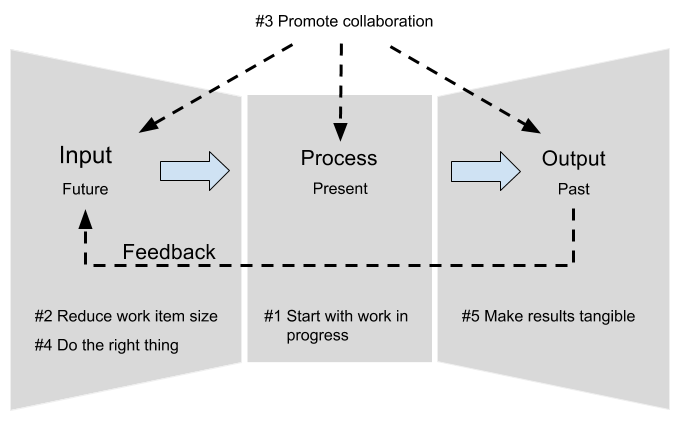It is difficult to come up with a plan when you find yourself in a dysfunctional environment. Everything is on fire and there is no time available. Tight deadlines, pressure, working overtime, unsatisfied customers, waste, and a whole lot of other chaotic stuff that piles up and makes it difficult to pick the most critical problem to fix.
I will offer guidance in situations like this with five strategies in a recommended sequence. They are aligned with Lean principles and will work as a guide whichever method you use, be it Scrum, Kanban, XP or any other.
These strategies came to my attention while attending a course called SoftwareZen, by Alisson Vale. Alisson is a Kanban pioneer here in Brazil and I strongly recommend his course to all Portuguese speakers out there.
The strategies were complemented with our experience at Plataformatec and the content I presented (here the slides in Portuguese) at Agile Floripa 2016.
An overview of the strategies
A work system, like any other system, has an input, a processing area, an output and a feedback loop:

To be generic, let’s call “work items” all things that flow in a working system. The processing area deals with work items related to the present, the system’s input has work items that will be processed in the future and the output has items that had already been worked on.
It’s a good practice to start improvement by looking at the “Present”. This will give good leverage to the actions applied. It doesn’t mean that “Future” and “Past” are not important, they are complementary. Learning with “Past” work items can make your “Future” ones better.
Having this in mind, this is how the strategies are related to the system areas and the recommended sequence to apply them:

In the following weeks, I’ll post the first two strategies, “Start with work in progress” and “Reduce work item size” as a preview of an ebook I’m writing, 5 Strategies to improve software development workflow. The e-book will feature the content below:
-
Start with work in progress: The first strategy shows why it’s a good idea to start looking at your system’s work in progress (WIP). Also, you will get to know how to do it through these practices:
- Making the current workflow tangible;
- Managing capacity;
- Promoting tactical coordination;
- Reduce work item size: Slicing work into smaller pieces helps creating a healthy workflow and is one of the principles of Lean thinking. I will recommend some techniques to do it with different types of work items.
- Promote collaboration: Which characteristics do you have to pursue to achieve collaboration in team and organizational levels? And which ones do you have to avoid? That will be addressed in the third strategy.
- Do the right thing: Capacity is precious. Working in stuff that doesn’t matter is pure waste. The fourth strategy is all about techniques to help ensure you are working on the most important thing at the moment, in business, product and team levels.
- Make results tangible: The last strategy brings some tips on giving visibility to achievements, mainly with metrics. This will help with predictability, sense of progress and also with data to drive continuous improvement.
The ebook will be available to download very soon. If you want to get the Portuguese version, click here.
Until then, leave your comments below and stay tuned for the upcoming weeks!